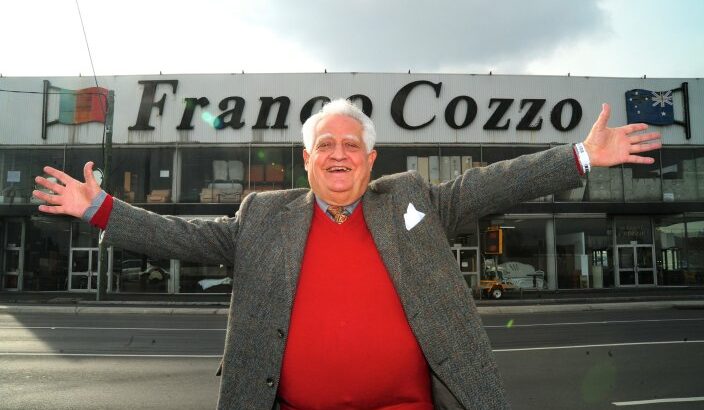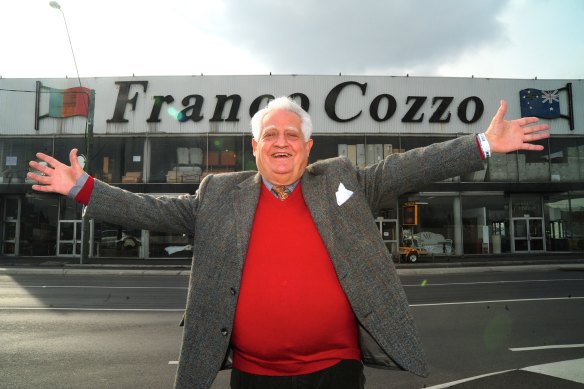Save articles for later
Add articles to your saved list and come back to them any time.
Few furniture retailers have achieved the iconic status of Franco Cozzo. His eponymous stores are well known across the Melbourne, but for many, he will remain best known for his unique commercials, which were first broadcast on commercial television in the early 1980s. Less known is the pioneering nature of these advertisements and the insights that they provide into our recent history.
When Cozzo commenced his first campaign, commercial television was a big deal. Dominated by giant brands like Coca-Cola and Qantas, with enormous budgets, slickly produced advertisements brought excitement and glamour into suburban living rooms.
Australian content regulations at the time meant that all commercials were produced in Australia. As a significant proportion of programming was imported from overseas, commercial breaks played a key role in expressing and celebrating Australianness.
However, the image of Australia in these commercials was a highly mediated one. Advertisers were remarkably uniform in the type of person who should appear in their commercials – being white, fair-haired, and blue-eyed seemed essential. Paul Hogan started off selling Winfield cigarettes before promoting Australian tourism to the world, while Naomi Watts famously declined dinner with Tom Cruise for a lamb roast with her family.
The sound of Australian commercials was also important. Australian accents became a feature of Australian advertisements in the 1970s. Campaigns such as “C’mon Aussie, C’mon” for the World Series Cricket and “You oughtta be congratulated” for Meadow Lea famously celebrated the voice of Australia. International advertisements would be similarly remade with an Australian voice – the “football, meat pies, kangaroos, and Holden cars” campaign for “Australia’s own” car was a localised version of “baseball, hot dogs, apple pies and Chevrolet”.
It was this idealised image of Australia that Franco Cozzo challenged. Cozzo had arrived in Australia in the 1950s as part of Australia’s great post-war immigration scheme. Starting out as a door-to-door salesman, he eventually opened his own furniture stores.
Located in Brunswick, Footscray and North Melbourne, Cozzo’s stores were tailored to the needs and tastes of the burgeoning migrant communities. By advertising on television, Cozzo reached an even larger audience, notably those who had moved out to the suburbs and were looking to furnish their larger homes.
Franco Cozzo outshide one of his stores in 2014.Credit: Joe Mastroianni
Cozzo’s commercials were different from the outset. Visually, they did not conform to any of advertising’s stereotypes. The production quality was not particularly high. The baroque style of furniture stood out from the conventional styles of furniture being sold by mainstream retailers. But the biggest difference was the salesman spruiking his wares. Everything about Cozzo’s appearance broke the advertising mould.
The sound of Cozzo’s advertisements similarly stood out from the pack. Advertising on commercial television was exclusively English-speaking. As migrant communities were Cozzo’s key demographic, he pioneered the use of non-English languages in mainstream commercial television. The sounds of Italian and Greek, coupled with the use of Sicilian-style folk music, successfully cut through the clutter and captured the attention of all audiences.
And when Cozzo did speak English, his commercials stood out even more. His accent and pronunciation of “Foot-a-scray” and “North-a-Melbourne” along with such taglines as “If it’s furniture you want to buy, Franco Cozzo’s not far away” were all memorable and, indeed, easily imitated.
The location of Franco Cozzo stores was another part of the commercials’ unique appeal. TV advertisements rarely featured the inner suburbs like Footscray, Brunswick, or North Melbourne.
The popularity of Cozzo’s advertising also stemmed from its programming. As rates for advertising on commercial television in the afternoon were low, afternoons often featured smaller retailers. Broadcast amid re-runs of I Dream of Jeannie or Simon Townsend’s Wonderworld!, Franco Cozzo commercials were seen, imitated, and celebrated by school children. For this generation, the commercials are still etched in the memory.
Revisiting Franco Cozzo’s commercials on YouTube, it is difficult to look beyond the kitsch and the nostalgia. The look and sound of the commercials remain different to any other commercials from the period, as well as those from the present. While these commercials helped create a beloved cultural icon, they also played an important role in projecting a more realistic and memorable image of modern Australia than those being depicted by major national advertisers.
Robert Crawford is professor of advertising in the School of Media & Communication at RMIT University.
The Opinion newsletter is a weekly wrap of views that will challenge, champion and inform your own. Sign up here.
Most Viewed in National
From our partners
Source: Read Full Article

